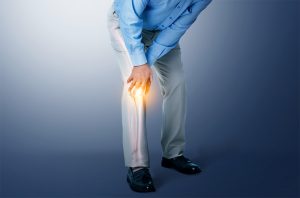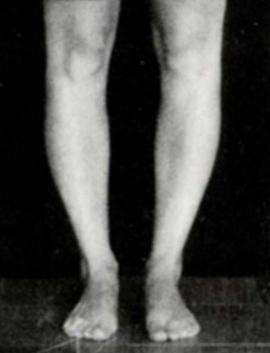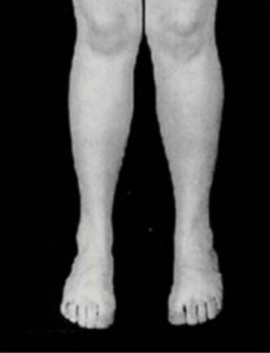
1. Frontal Knee pain – 60% of the knee pain
60% of knee pain is frontal knee pain.
It is caused by ‘weakness of the tendon and muscles of the knee’ and ‘twisting of the knee due to knee deformation’.
EMS treatment is used to improve the symptoms quickly.
- Tendon lesion around the patella (knee bone)
Pain located above or below the knee bone.
The pain intensifies when going down a slope or downstairs. The pain increases when performing knee-related activities, such as running or jumping. The quadriceps muscles that stretch the knees merge into a tendon wrap around the knee bone and attach to the lower leg.
The weakness of the quadriceps muscles, problems with elasticity, deformation, and twist of the knee, and differences in leg length cause damage and inflammation to the tendons around the knee bone, resulting in knee pain.
2) Bursitis around the patella
There is pain and swelling under the patella. It is difficult to come downstairs or kneel. There is sharp pain when waking up in the morning and moving the knee. Swelling and fluid accumulation often occurs around the knee bone. There are several mucous sacs around the knee bone that act as a lubricant to prevent friction between the ligaments and tendons. If the knee is overly used, and rubbing the mucous sac causes acute damage, causing pain.
2. Difficult to treat Posterior knee pain
Pain in the back of the knee causes by deformation of the leg, such as the O leg, the X leg, and the knee bent back.
It is easy to occur when the damage persists due to overuse without giving enough healing time.
 |
 |
|
| O shape leg | X-shape leg | Backward of the knee bent |
- Biceps femoris tendinosis
- Gastrocnemius lateral head tendinosis
- Popliteus tendinosis
The cause of pain in the back of the knee is knee deformation caused by an imbalance in the feet and pelvis.
Therefore, to get rid of pain, straight knee deformation is the priority.
In other words, the primary treatment for pain is to correct the underlying cause of knee deformation, ‘foot, and pelvis imbalance’.
In MBR ACUPUNCTURE & HERB is using EMS therapy to quickly fix pains in the back of the knee by straightening the feet, pelvis, and spine.
8-3. Medial Knee pain : Knee trauma, due to repeated micro-injuries
Knee trauma, due to repeated micro-injuries Pain inside the knee
It often occurs when the knee is bent inward during exercise. Excessive knee use or torsion of the foot causes friction and inflammation and aggravates the pain. If inflammation becomes chronic, calcification may also occur. Through MBR EMS knee therapy, it improves quickly from cause to symptom.
- Medial collateral ligament InjuryPain location is inside of the knee when it can get injured, the knee bending inward or turned, or when it is bent out.
It is typically caused by trauma due to skiing or knee bending inwards during exercise. - Sprain of the coronary ligament It is often diagnosed as meniscus damage.
Pain is inside of the knee or knee joint line.
The pain increases when the knee rotates outward.
Even after injury, you can continue walking or exercising regularly.
The pain intensifies over time swelling, limited exercise, and discomfort in walking appear. Because of the high distribution of blood vessels and nerves, pain may occur well, but it is also effective when the treatment is in progress. If you feel pain, it is better to treat it immediately.
Sprain of the coronary ligament Often diagnosed as meniscus damaged Pain in the knee or in the knee joint line. Pain increases when the knee is rotated outward. Even after injury, you can continue walking or exercising normally The pain intensifies over time Swelling, limited exercise, and discomfort in walking appear. Because of the high distribution of blood vessels and nerves, pain may occur well, but it is also effective when the treatment is in progress. If you feel pain, it is better to treat it immediately.
- PES Anserine Tendonitis / Bursitis
When bending the knees or turning feet outward to increase pain. Often it isn’t easy to go down the stairs. Pain is persistent and stiff. The inside of the knee swelling or fluid accumulation usually occurs. Several mucous sacs around the knee bone act as a lubricant to prevent friction between the ligaments and tendons. When fall or the knee is twisted, and excessive friction occurs, acute damage to the mucous sac can cause pain.
4. O shape legs or it occurs after ankle sprain/strain
Lateral Knee Pain
- IT Band Friction Syndrome
It occurs mostly on O-type legs or flat feet.
People who have O-type legs often have symptoms because the lateral ligament is likely to rub on the knee. It usually occurs after running or cycling and bending. The pain is persistent, stiff, and often some patients are unable to kneel or walk down the stairs.
| It occurs when the ankle is not fully recovered after an ankle sprain. | Due to high Arch | Causes instability in tibia and fibula joints |
2. Proximal Tibiofibular Joint Injury
Pain outside the knee may occur if the ankle does not recover after pulling it out or high arch on foot. In the above case, it causes instability in the tibia and fibula joints, so the knee easily twists, and pain appears. If pain is experienced on the lateral knee, especially when walking on an inclined area, or when sitting on a desk, it should suspect damage to the joints of the proximal tibiofibular joint. It needs EMS knee treatment.